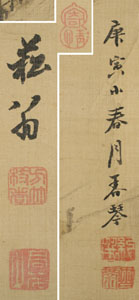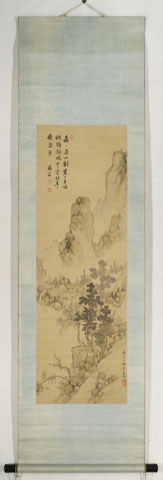Nanga
Summer landscapeSigned: Shunkin, Sûô
Seals: Kisen Shunkin, Hôchiku Jôsha, Kummo
Technique: colours on silk 112.4x 36.5
Date: Spring of 1830
Mounting: light blue Chinese damask 184 x51
Condition: good
森森屋山封 / 晝日有鳴蜩 / 猶聽城中客 / 終年厭眾囂
The forest rises above the roofs of the houses;
the chirping of cicadas all day long.
I also hear the people in the city;
the noise annoys me all year round.
Quotes from The Book of Odes and The Book of Changes.
Shunkin was born in Bizen, the eldest son and pupil of Uragami Gyokudō (1745-1820), a retainer of the Okayama Shinden Clan. Together with his father they left the clan in 1794 and for five years they traveled through Japan together. During his stay in Osaka he became well acqainted with Kimura Kenkado (1736-1802), sake brewer, bunjin, and collector. This collection became of importance for Shunkin’s kachô paintings. He settled in Kyoto in 1799. Shunkin joined the conservative bunjin group around Rai San'yô (1780-1832) and Shinozaki Shōchiku (1781-1851). At times he collaborated with Yamamoto Baiitsu (1783-1856). His paintings show influences from the Maruyama School as well from Nagasaki kachōga, flower and bird painting.
Reference:
Fukushima ’94 p. 61-83
Berry & Morioka ’08 p. 309
Rosenfield B.101
Hempel p. 170 (# 16)
Roberts p. 156
Araki p. 1301
Kaioku, was born as the second son of a martial arts teacher in the service of the Hachisuka domain in Awa Province. Although he was educated in the family tradition of martial arts, his weak constitution allowed him to follow Confucian studies, poetry and calligraphy.
After a brief training in Kanô painting he went to Nagasaki to study Nanga painting under the Zen-monk Hidaka Tetsuô (1791-1871). He chose to be a Confucian scholar for which he studied in several parts of Japan for many years of his life. For three years he studied calligraphy. He copied the style of the 9th century monk Kôbô Daishi permanently and mastered all the styles of calligraphy. After the death of Rai San'yô (1780-1832), Kaioku became the most celebrated bunjin artist in Kyoto.
In each of the editions of the Heian Jinbutsu shi from 1813 until 1852 Kaioku is mentioned twice as a poet as well as a calligrapher. In 1811 he settled in Kyoto where in 1828 he finally established the Suseidô, his own school.
Reference:
Rosenfield ‘99 B.68
Berry & Morioka ’08 p. 287-88
Kato '98 (Chapter 1) # 94-102
Hempel p. 165
Roberts p. 64
Araki p. 1580 ff.
Price: ON REQUEST

